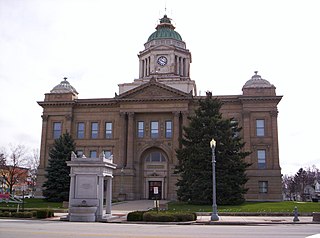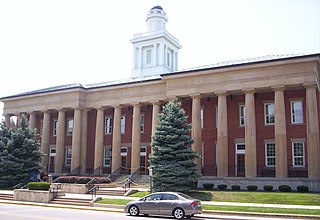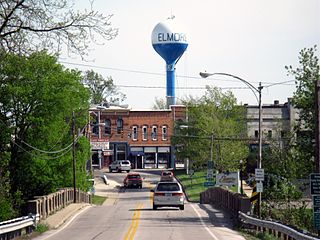
Wyandot County is a county located in the northwestern part of the U.S. state of Ohio. As of the 2020 census, the population was 21,900. Its county seat is Upper Sandusky. It was named for the Wyandot Indians, who lived here before and after European encounter. Their autonym is variously translated from their language as "around the plains" and "dwellers on the peninsula". The county was organized by the state legislature from parts of Crawford, Marion, Hardin and Hancock counties on February 3, 1845.

Seneca County is a county located in the northwestern part of the U.S. state of Ohio. As of the 2020 census, the population was 55,069. Its county seat is Tiffin. The county was created in 1820 and organized in 1824. It is named for the Seneca Indians, the westernmost nation of the Iroquois Confederacy. This people were based in present-day New York but had territory extending into Pennsylvania and Ohio. Seneca County comprises the Tiffin, OH Micropolitan Statistical Area, which is also included in the Findlay–Tiffin, OH Combined Statistical Area.

Sandusky County is a county located in the northwestern part of the U.S. state of Ohio. As of the 2020 census, the population was 58,896. Its county seat and largest city is Fremont. The county was formed on February 12, 1820, from portions of Huron County. The name is derived from the Wyandot word meaning "water". The Sandusky River runs diagonally northeast through the county to its mouth on Sandusky Bay, opening into Lake Erie. Sandusky County compromises the Fremont, OH Micropolitan Statistical Area.

Crawford County is a county located in the north central portion of the U.S. state of Ohio. As of the 2020 census, the population was 42,025. Its county seat and largest city is Bucyrus. The county was created in 1820 and later organized in 1836. It was named for Colonel William Crawford, a soldier during the American Revolution. Crawford County comprises the Bucyrus, OH Micropolitan Statistical Area, which is also included in the Mansfield-Ashland-Bucyrus, OH Combined Statistical Area.

Clyde is a village in Wayne County, New York, United States. The population was 2,093 at the 2010 census. It was named after the River Clyde, in Scotland, and the village sits on the Clyde River, a tributary of the Seneca River.

Bay View is a village in Erie County, Ohio, United States. The population was 608 at the 2020 census. It is part of the Sandusky, Ohio Metropolitan Statistical Area.

Willard is a city in southwestern Huron County, Ohio, United States, approximately 14 miles (23 km) southwest of Norwalk. The population was 6,197 at the 2020 census.

Burgoon is a village in Sandusky County, Ohio, United States. The population was 183 at the 2020 census.

Clyde is a city in Sandusky County, Ohio, located eight miles southeast of Fremont. The population was 6,294 at the time of the 2020 census. The National Arbor Day Foundation has designated Clyde as a Tree City USA.

Gibsonburg is a village in Sandusky County, Ohio, United States, about 33 miles (53 km) southeast of Toledo. The population was 2,452 at the 2020 census. The National Arbor Day Foundation has designated Gibsonburg as a Tree City USA.

Helena is a village in Sandusky County, Ohio, United States. The population was 211 at the 2020 census.

Lindsey is a village in Sandusky County, Ohio, United States, near the halfway point of the route between Detroit and Cleveland. The population was 457 at the 2020 census. The National Arbor Day Foundation has designated Lindsey as a Tree City USA.

Attica is a village in Seneca County, Ohio, United States. The population was 873 at the 2020 census.

Bettsville is a village in Seneca County, Ohio, United States. The population was 595 at the 2020 census.

Bloomville is a village in Seneca County, Ohio, United States. The population was 867 at the 2020 census.

Republic is a village in Seneca County, Ohio, United States. The population was 556 at the 2020 census.

Tiffin is a city in and the county seat of Seneca County, Ohio, United States. Developed along the Sandusky River, Tiffin is located about 55 miles (89 km) southeast of Toledo. The population was 17,953 at the 2020 census.

Upper Sandusky is a city in and the county seat of Wyandot County, Ohio, United States, along the upper Sandusky River. The city lies approximately 59 miles (95 km) south of Toledo and 62 miles (100 km) north of Columbus. The population was 6,698 at the 2020 census.

Bellevue is a city in Erie, Huron, Seneca, and Sandusky counties in the U.S. state of Ohio, located 61 miles southwest of Cleveland and 45 miles southeast of Toledo. The population was 8,249 at the 2020 census. The National Arbor Day Foundation has designated Bellevue as a Tree City USA.

Elmore is a village in Ottawa and Sandusky counties in the U.S. state of Ohio. The population was 1,370 at the 2020 census.
























